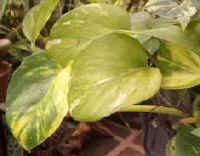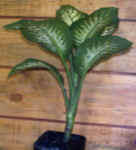| Back |
BEST BEGINNERS' CHOICES |
Home |
|
Low Maintenance Indoor Plants |
|
|
PHILODENDRONS
This is probably the largest, most familiar and most
adaptable family of houseplants around.
Philodendrons are natives of the rainforest, so they’re perfectly
at home wherever it’s humid. Many types will climb up any nearby structure.
Others, like the “Temptation” (pictured above) may opt to trail
gracefully down the sides of a container. They are so easy to care for, it’s almost impossible to
find a home that doesn’t have at least one variety of philodendron
tucked away somewhere.
CARE: Wash
leaves once in a while to get rid of dust.
Too much dust further diminishes the amount of light the leaves are
able to absorb for food production. Keep
soil moist but not soggy. Feed
every two weeks to every quarter; feeding the smaller varieties and those
grown indoors more frequently.
LIGHT: Bright
indirect light is best but they can survive in the shade.
If new growth looks weak and has small leaves, move the plant to an
area with brighter light but no direct sun.
MEDIUM: Grows well in Plantastic
soil-less potting mix.
PROPAGATION: Cuttings
and division.
|
 |
|
|

Golden pothos |
GOLDEN POTHOS
Tops in versatility and ease of growth, this makes
the Golden Pothos an excellent first choice for beginners.
Put it in a pot, or in a hanging basket.
Let it climb or let it trail – the pothos will gladly oblige and
give you a graceful show of leaves. Its
quick rate of growth is very rewarding, even the brown-thumbed will be
pleased with their success in no time.
The best part is that, unlike many houseplants, its patterned
leaves don’t lose their color variations even when grown in a dark
setting. Its quiet grace,
ease of growth and maintenance, high adaptability, and resistance to pests
and diseases makes it our #1 recommendation for newcomers to indoor
gardening.
Although it looks like the common philodendron vine,
pothos is not a philodendron but the two plants are related.
“Golden” pothos is the most popular variety.
“Marble Queen” is just as easy to care for and has even more
remarkable leaf colorations, but is a much slower grower.
“Jade” is the least popular because of its relatively plain
green leaves.
CARE: Cuttings
easily root in water, which is perhaps why it has unfortunately acquired
the name “water plant” locally. Once
roots form, the plant should be transplanted into standard potting mix.
In fact, you should even let the soil dry slightly between
waterings to keep the plant happy. To
encourage bushiness, pinch off the growing tips.
Clean the leaves periodically with a damp cloth to remove dust.
Dust further diminishes the amount of light the leaves can absorb
for food production. To keep
growth slow, keep plants somewhat pot-bound.
LIGHT: Partial
shade to shade
MEDIUM: Grows
well in Plantastic soil-less potting mix.
PROPAGATION: Cuttings
and division.
|
|

Marble Queen Pothos
|
|
SNAKE PLANT
Also known as sansevieria, mother-in-law’s tongue, and sword
plant or espada, this plant has quite an assortment of names that the
conversation it triggers alone is good enough reason to have it around!
But more than that, the tall and slender leaves make striking contrast
when mixed with other plants. On
its own, in a container, it also makes quite a simple yet elegant
statement. They occasionally
bloom, but if kept indoors, it may be best to remove the dainty, fragrant
white flowers because they release a sticky substance.
A nocturnal worker, the snake plant removes carbon
dioxide from the atmosphere and converts it to oxygen at night.
CARE: Almost
indestructible, this plant can endure neglect, dim light, haphazard
watering, heat, dust, dry air and is rarely attacked by insects.
Because they are succulent, leaves store water for the plant, so
keep soil or potting mix on the dry side.
Feed monthly. Repot yearly.
LIGHT: Semi-sun,
partial shade or shade
MEDIUM: Grows
well in Plantastic soil-less potting mix.
PROPAGATION: Division
and cuttings. Cuttings of variegated varieties may revert to green.
|

|
|
|
 |
Schefflera
Commonly known as the umbrella tree, this stately plant comes in a
variety of shades and sizes. If you're on the lookout for a big indoor
plant, you can get the schefflera species that can grow up to 10 feet
indoors! Or, if you like this plant's shape but not in that size, then go
for the new dwarf varieties (The variegated dwarf variety pictured at left
is available in limited quantities at GreenHearts). Just in case you've gotten yourself a plant
which is growing a bit too big for the space you've given it, you can
reduce its height by pruning the main stem back to a node (the point at
which leaves join the stem).
Schefflera have long stems with 7 to 16 polished leaves which are green
or in variegated form. Their formation resembles the ribs of an umbrella
and, thus, its common name. This plant is perfect for the beginning
gardener because it's so easy to care for. Contained in pots, older plants
can also turn into very handsome "bonsai-like" specimens with
hardly any need for wires or training. Simply water thoroughly, allowing
the potting medium to dry out slightly between waterings. Feed with water
soluble fertilizer once or twice a month. Mist once in a while to reduce
the risk of insect infestation.
Schefflera is very good at removing chemical vapors and also has above
average performance when it comes to releasing moisture into the indoor
environment.
If ever it has a drawback, it would be susceptibility to insect
infestation, but only in the case of very dry indoor environments, which
is rare in our country. |
|
|
Calathea
These lovely foliage plants have leaves that are mottled
or striped and come in an amazing range of greens. To produce the
best colors, they should be fed regularly or plant them in Plantastic
Low Maintenance Mix. Keep them moist, in partial shade.
Leaves burn easily in direct sunlight.
|
 |
|
|

Back to top |
DUMB CANE
Dieffenbachia
This is a popular plant that many people recognize but simply cannot
name. All species of dieffenbachia are commonly called dumb cane because
of their sap. Should you be unwise enough to bite any part of the plant,
the calcium oxalate in the sap will cause your throat to swell and loss of
speech can last for several days. (Now, don’t play any tricks on that
talkative person! All parts of the plant are poisonous! )
The plant’s broad leaves help add moisture to the surrounding air. It
prefers bright, filtered light so it would be best to locate it near a
window. Too dark a setting will cause the variegated leaves to lose their
attractive color.
This plant does not tolerate drought so keep the potting medium moist
and mist it often. |
|
|
